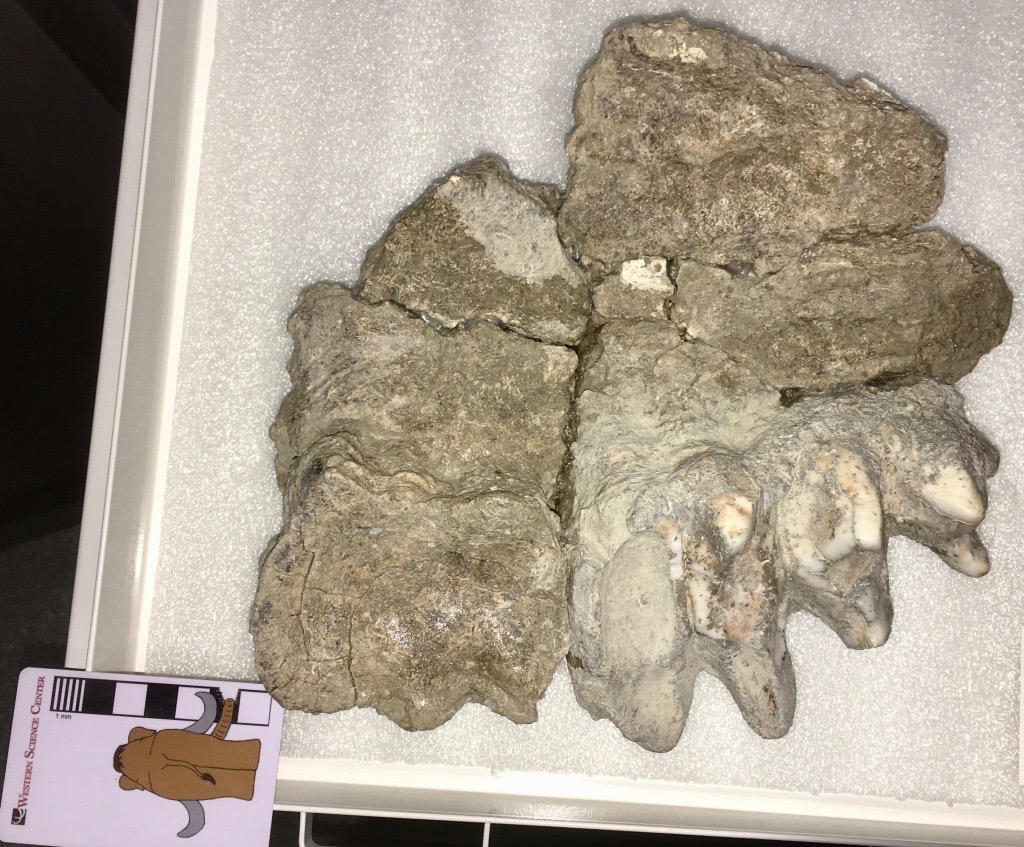 The Valley of the Mastodons exhibit has closed, and most of out mastodon remains have been moved back to the museum's repository. But that doesn't mean they're forgotten, or that work on them has stopped!This specimen is a fragment of a mastodon palate, with the anterior end on the left. Most of the left side of the palate is missing, but the right side (at the bottom of the image) includes the complete 2nd and 3rd molars. Even a small fragment like this tells us quite a bit about mastodons.Like other advanced proboscideans, mastodons replaced their teeth horizontally instead of vertically like most mammals. That means that during the mastodon's life it gradually works it's way through six teeth in each quarter jaw, one after another - the 2nd, 3rd, and 4th premolars, and the 1st, 2nd, and 3rd molars (we're ignoring the tusks here, which are also teeth). With this pattern of tooth replacement, by looking at which teeth are present in the mouth and how worn the teeth are, we can make a reasonably precise estimate of how old the mastodon was when it died.In 1966, British biologist Richard Laws published a detailed description of how tooth wear and replacement rates relate to age in African elephants, which has become the standard starting point for estimating proboscidean ages. He divided the elephant life cycle into 30 tooth wear stages, which are now called Laws groups. So, for example, an African elephant with the 4th premolar heavily worn and the 1st molar just about to erupt would be in Laws group VII, which would make it 6 years old, ± 1 year.With some limitations, this same system works pretty well for mastodons even though they're only distantly related to elephants. Because there is some uncertainty involved, when applied to extinct elephants the age indicated by the Laws group is usually expressed in terms of AEY (African Equivalent Years), the age that an African elephant would be in the same wear state.So how about this mastodon? The 2nd molar is still present, but is almost completely worn away; there is only a thin band of enamel remaining around the edges. The 3rd molar shows lots of wear on the 1st loph at the front of the tooth, somewhat less on the 2nd loph, light wear on the 3rd, and little or no wear on the 4th. That puts this mastodon into Laws group 22, with an age of 39 ± 2 AEY, a fully mature but not yet elderly mastodon. We actually have several mastodons from Diamond Valley Lake that fall into Laws group 22, including Max, our largest and best-preserved skull.This particular mastodon was discovered at the West Dam of Diamond Valley Lake, making it between about 14,000-20,000 years old. Reference:Laws, R. M., 1966. Age criteria for the African elephant, Loxodonta a. africana. East African Wildlife Journal 4:1-37.
The Valley of the Mastodons exhibit has closed, and most of out mastodon remains have been moved back to the museum's repository. But that doesn't mean they're forgotten, or that work on them has stopped!This specimen is a fragment of a mastodon palate, with the anterior end on the left. Most of the left side of the palate is missing, but the right side (at the bottom of the image) includes the complete 2nd and 3rd molars. Even a small fragment like this tells us quite a bit about mastodons.Like other advanced proboscideans, mastodons replaced their teeth horizontally instead of vertically like most mammals. That means that during the mastodon's life it gradually works it's way through six teeth in each quarter jaw, one after another - the 2nd, 3rd, and 4th premolars, and the 1st, 2nd, and 3rd molars (we're ignoring the tusks here, which are also teeth). With this pattern of tooth replacement, by looking at which teeth are present in the mouth and how worn the teeth are, we can make a reasonably precise estimate of how old the mastodon was when it died.In 1966, British biologist Richard Laws published a detailed description of how tooth wear and replacement rates relate to age in African elephants, which has become the standard starting point for estimating proboscidean ages. He divided the elephant life cycle into 30 tooth wear stages, which are now called Laws groups. So, for example, an African elephant with the 4th premolar heavily worn and the 1st molar just about to erupt would be in Laws group VII, which would make it 6 years old, ± 1 year.With some limitations, this same system works pretty well for mastodons even though they're only distantly related to elephants. Because there is some uncertainty involved, when applied to extinct elephants the age indicated by the Laws group is usually expressed in terms of AEY (African Equivalent Years), the age that an African elephant would be in the same wear state.So how about this mastodon? The 2nd molar is still present, but is almost completely worn away; there is only a thin band of enamel remaining around the edges. The 3rd molar shows lots of wear on the 1st loph at the front of the tooth, somewhat less on the 2nd loph, light wear on the 3rd, and little or no wear on the 4th. That puts this mastodon into Laws group 22, with an age of 39 ± 2 AEY, a fully mature but not yet elderly mastodon. We actually have several mastodons from Diamond Valley Lake that fall into Laws group 22, including Max, our largest and best-preserved skull.This particular mastodon was discovered at the West Dam of Diamond Valley Lake, making it between about 14,000-20,000 years old. Reference:Laws, R. M., 1966. Age criteria for the African elephant, Loxodonta a. africana. East African Wildlife Journal 4:1-37.
